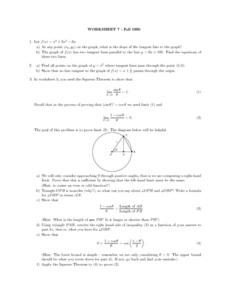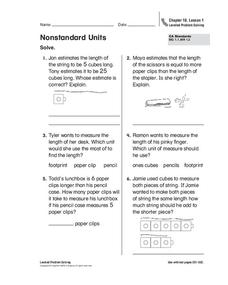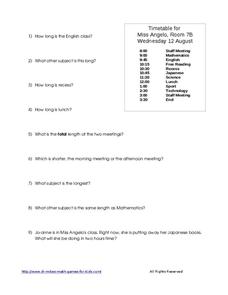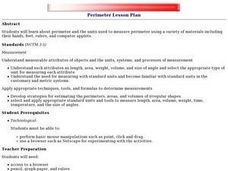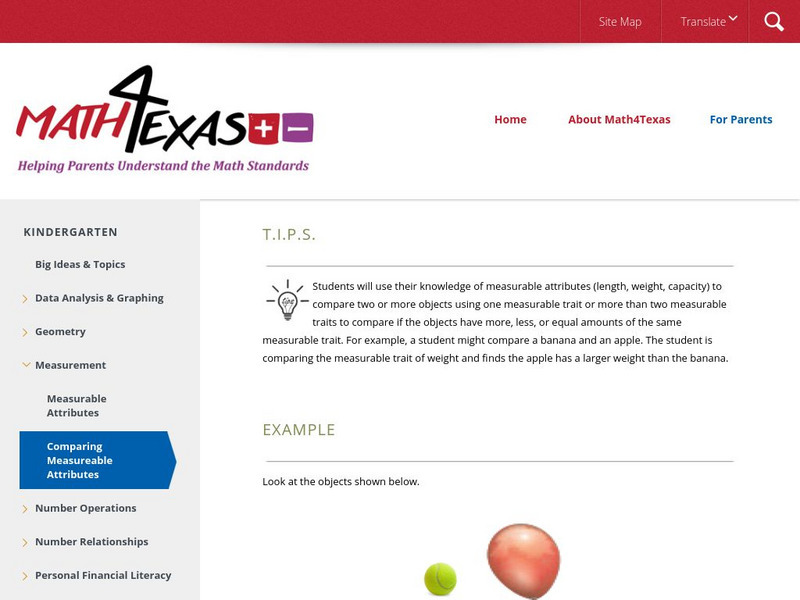Illustrative Mathematics
Longer and Heavier? Shorter and Heavier?
For many young children it seems obvious that longer objects are heavier than shorter objects. This assumption is put to the test as the class investigates the relationship between length and weight in a whole-group activity. Using a...
Curated OER
Geometric Shapes- Draw a Longer Version
In this geometric shape worksheet, 1st graders name each of three shapes in the first column of the worksheet. They draw the same shape in the space to the right, making the new shape longer than the original. They draw a rectangle, an...
Curated OER
Relations and Graphs
Here is a simple, yet clever lesson on how to teach the important concepts of greater than, less than, and equal to. Pupils write their names down on grid paper - one letter per box. They compare their names and find a name that is...
NASA
Resolving 2-Plane Traffic Conflicts by Changing Route—Problem Set B
Do pilots create appropriate spacing between aircraft by traveling a longer or shorter path? An interactive presents two airplanes that violate safety protocols. Pupils must determine how to change the path of one plane to create the...
Bowland
Mystery Tours – Plan Your Tour
Everyone loves a vacation and a set of three activities has groups planning a tour of the U.K. using given distance, time, and price data. They solve a variety of problems related to the trip and produce a report on the success of the trip.
Curated OER
Relating Space and Plane Shapes
In this mathematics worksheet, 1st graders identify which object in an illustration has a flat side the same shape as the box shown. Then they look at other shapes and identify the ones with a flat side, if any.
Curated OER
Piglets
Students are asked have they ever seen a pig? They are asked what are young pigs called? Students are given the Pigs Display Sheet. They see that on the sheet there are two piglets and their mother. Students are told that mother pigs are...
Curated OER
How Long is a Hot Dog? Weight, Weight! Don't tell me!
Primary learners participate in activities that help them explain how different things are measured. They create their own access number chart.
Curated OER
Length
Without using a ruler, learners estimate the relative length of various lines in these three scenarios. The first two are set up as maps, with learners determining the shortest and longest distances from one position to another. The last...
Curated OER
Worksheet 7: Slope and Tangents
Providing both review and practice problems, this worksheet prompts students to answer five questions having to do with slope, tangents lines, graphing, the Squeeze Theorem, differentiable functions and derivatives. This activity could...
Curated OER
Nonstandard Units
Measuring length with nonstandard units is the focus of this word problem activity. Youngsters problem solve using cubes, paper clips, footprints, and pencils. They solve six problems.
Virginia Department of Education
Mathematics Vocabulary Cards - Kindergarten
Enhance your math lesson with a series of pictures that illustrate different math concepts. The vocabulary includes a variety of ideas and pictures including fractions, ordinal numbers, picture graphs, and number lines.
EngageNY
Mid-Module Assessment Task - Geometry (Module 2)
Challenge: create an assessment that features higher level thinking from beginning to end. A ready-made test assesses knowledge of dilations using performance tasks. Every question requires a developed written response.
Curated OER
Why Standard Units?
A variety of units of measurement are taught in this math worksheet. First, students measure objects using their hands. Then, they use a ruler to gain more precise measurements in meters and centimeters. Nice worksheet!
Curated OER
What Time Is It?
In this clocks worksheet, students first read a one page text about different kinds of clocks. Using a word bank, students label the parts of four different kinds of clocks: grandfather, wristwatch, digital and analog. Students write the...
Curated OER
Ordering Objects By Length
Students compare and describe objects of differing lengths that are presented in a Mathkeys software compare mat. Working in pairs, one student is the chooser who sets up the objects while the other student is the sizer who puts the...
Curated OER
Measuring and Comparing Length
Students measure objects in the classroom. For this measurement lesson, students compare items using their height, use paper clips to measure things and record their findings.
Curated OER
The Lawnmower Problem
In this algebra instructional activity, students solve a word problem by rewriting it using math symbols. They calculate how fast the woman can mow the lawn given different scenarios. There is an answer key.
Curated OER
Timetable: subjects for the day
In this time table worksheet, students view the subjects and schedules for different classes for the day and answer time related questions about them. Students look at 4 schedules and answer 31 questions total.
Curated OER
Perimeter
In this perimeter worksheet, students, with a partner, problem solve and calculate the answers to twenty word problems and mathematical calculations involving perimeters.
Curated OER
Addition and Subtraction word problems
In this word problems worksheet, students solve addition, subtraction, money, decimals, and percentage word problems. Students solve 47 problems total.
Curated OER
Bearly There
First graders read "How Long Is A Foot?" together and use paper clips, teddy bears, crayons and other non-standard units to measure items. They compare the items measured and order them from longest to shortest.
Curated OER
Making Tangram Pieces by Folding Paper
Third graders follow directions to make a set of tangram pieces. After reading a story, they compare and contrast the differences between two-dimensional shapes. To end the lesson, they use the tangram pieces to create their own...
Other
Math4 Texas: Comparing Measurable Attributes
Students will use their knowledge of measurable attributes (length, weight, capacity) to compare two or more objects using one measurable trait or more than two measurable traits to compare if the objects have more, less, or equal...











